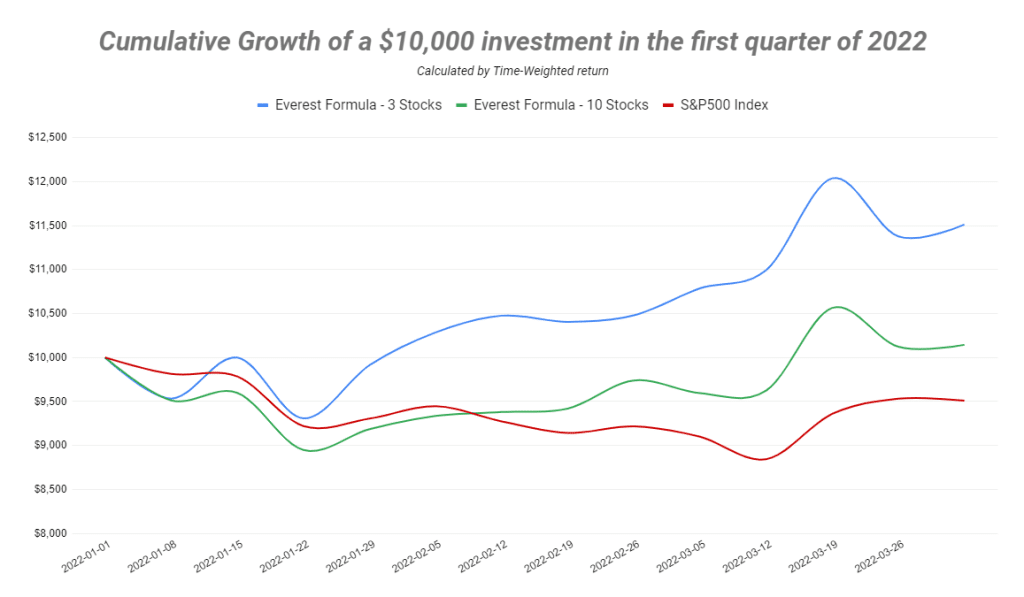- The first 3 months of 2022 have brought strong upsets in the stock market, caused by the war in Ukraine, a rushing inflation and the first interest rate hikes. These have led to the negative sign for all major stock markets around the world, including the S&P500.
- In this article we are going to see how the Everest Formula has performed across this unusual period in comparison with the U.S. indices, also looking at the outlook on the next months.
A review of the last 3 months
The first 3 months of 2022 were dominated by strong uncertainty in the financial markets: on one hand, the unexpected outbreak of the first war in decades on European soil brought panic to the economy, with the price of raw materials skyrocketing, while stock indices suffered a hard blow, only partially cushioned in March. On the other hand, inflation has continued to run, and governments around the world have been forced to make the first (but certainly not the last) interest rate increase in years. As we have seen in this article, that has penalised companies, especially those which are most dependent on future growth and on the ease of issuing debt.
As if that were not enough, the difficulties in the supply chain and distribution of goods are continuing, triggered by the pandemic and are not fully resolved yet: semiconductors are continuing to be in short supply and shipping costs to be at an all-time high. This has a negative impact on almost every sector of the current economy.
These are the reasons why it is not surprising that the S&P 500 index has reached -12.9% from its peak at the beginning of the year, only to recover and close the first quarter at -4.9%. The Nasdaq even touched -19.6%, driven down by its technology stocks, to finish the quarter at -8%.
How has Everest Formula performed in this environment? Once again, the results were surprising: although it initially followed the negative trend of the stock indices (the 3-stock and 10-stock strategies recorded respectively -7.6% and -11% after the first 20 days of the year), the rebound was sudden, and although the very volatile quarter, it managed to close the quarter with a positive balance: in fact, the 3-stock strategy closed on March 31 with a consistent gain of +15.1%, while the 10-stock strategy gained a more limited +1.4%, but with less volatility.
The Everest Formula has also managed to beat the market in this turbulent period, even maintaining the capital with a smaller decline than the index. Despite this, we need to outline that the volatility was higher than the S&P500. As we highlighted many times, any strategy that uses only few stocks (like the Everest Formula) has a remarkable volatility, that can worry investors who are less risk-tolerant. For this reason, we suggest to apply our strategy on the risky part of your overall portfolio, the one that aims towards greater profits.
What is the outlook on the coming months?
Although the good quarterly reports of U.S. companies are bringing relief to the stock market, the reasons why the first period of 2022 was turbulent have not faded away: the war in Ukraine is still far from being resolved, inflation continues to run, the Fed may be forced to raise rates by the end of the year as never before in recent history, while the news of the last days is the dreaded inversion of the yield curve in the bond market, a historical sign of a probable imminent recession. No one can know how the market will behave in the near future, but the signs are currently not encouraging.
What about the Everest Formula? Many investors in the past have asked us how the Everest Formula will perform in the event of a recession or market crash. Although past performance is no guarantee for the future, backtests show that in the last 22 years during negative periods for the stock market (e.g. 2000, 2008, 2020) the Everest Formula initially followed the negative market trend but then rebounded faster, as it did on a small scale in the last 3 months.
We don’t know whether the Everest Formula will continue to beat the market month after month, but we firmly believe that selecting good companies at a bargain price will always be a good investment strategy.
If you want to find the best profitable and undervalued stocks in the market, join us now.



